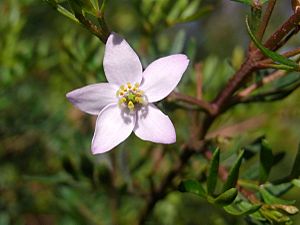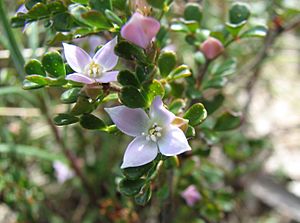Boronia facts for kids
Quick facts for kids Boronia |
|
|---|---|
 |
|
| Boronia fraseri at the Glenbrook Native Plant Reserve, NSW | |
| Scientific classification |
|
| Kingdom: | Plantae |
| Clade: | Tracheophytes |
| Clade: | Angiosperms |
| Clade: | Eudicots |
| Clade: | Rosids |
| Order: | Sapindales |
| Family: | Rutaceae |
| Genus: | Boronia Sm. |
| Species | |
|
About 160; see List of Boronia species |
|
Boronia is a group of about 160 types of flowering plants. They belong to the citrus family called Rutaceae. Most of these plants grow only in Australia. A few species are also found in New Caledonia.
Boronias look similar to other plants like Zieria, Eriostemon, and Correa. But you can tell them apart by counting their petals or stamens. Some Boronia plants have a very special smell. This makes them popular plants for gardens.
Contents
What Do Boronia Plants Look Like?
Most Boronia plants are shrubs. This means they are woody plants smaller than trees. A very small number are herbs (plants with soft stems) or small trees. Their leaves usually grow in pairs opposite each other. The leaves can be simple, or they can be compound. Compound leaves have many smaller parts called leaflets. Some Boronia leaves can have up to nineteen or more leaflets.
The flowers usually grow in groups where the leaves meet the stem, or at the ends of branches. Boronia flowers have both male and female parts. They usually have four separate sepals. Sepals are like small leaves that protect the flower bud. They also usually have four separate petals. Most Boronia flowers have eight stamens. Stamens are the male parts of the flower. There are also four carpels, which are the female parts. Each carpel has two ovules, which can become seeds.

How Boronia Got Its Name
The group of plants called Boronia was first officially named in 1798. This was done by a scientist named James Edward Smith. He wrote about it in a book called Tracts Relating to Natural History.
The name Boronia was given to honor Francesco Borone. He was an Italian naturalist and plant collector. Francesco Borone helped other scientists with their plant studies. He worked with them in places like Greece, Turkey, and Sierra Leone.
There is also a suburb in Melbourne, Australia, called Boronia. This place was named after a Boronia plant that grew there.
Where Do Boronia Plants Grow?
Boronia plants are found all over Australia. You can see them in every state and mainland territory. They usually grow in open forests or woodlands. It is rare to find them in rainforests or very dry areas.
Growing Boronia in Gardens
Many people like Boronia plants because of their lovely smell. B. megastigma is especially famous for its fragrant flowers. Most Boronias are beautiful plants to have in a garden.
However, many types of Boronia can be tricky to grow. They need special care to thrive. All Boronia plants need soil that drains water very well. They also prefer to grow in places that get some shade, not full sun all day.
See also
 In Spanish: Boronia para niños
In Spanish: Boronia para niños


